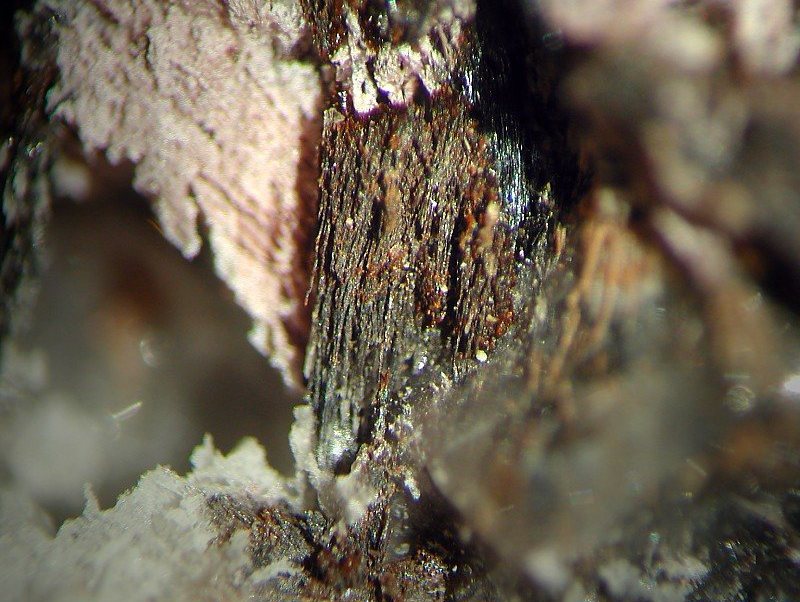Macfallite (incl.)
MacFallite is a relatively new mineral species discovered in 1974 at the Manganese Mine, Copper Harbor, Keweenaw County, Michigan, USA. MacFallite occurs as radial aggregates of reddish-brown or maroon to the dull pink compact massive material. It is also found as tiny, reddish brown radial crystal inclusions in Quartz along with inclusions of orange skeletal crystals of Johnsenite-(Ce) (incl.) and black Braunite crystals from the Arthur Costa mine, Jaguaracu, Minas Gerais, Brazil. The picture above shows a faceted Quartz gem with inclusions of a reddish brown radiating crystal of MacFallite along with an orange skeletal crystal of Johnsenite-(Ce). If you place your cursor over the picture you will see a magnified picture of the MacFallite crystal.
MacFallite was named by Paul Moore et al. to honour author and amateur mineralogist Russell Patterson MacFall (1903-1983) from Illinois, USA. Russell “Russ” MacFall, was a consummate newspaperman and the author of several books and hundreds of magazine articles on mineral collecting. Among his books were Gem Hunter’s Guide (1951, 1958, 1963, 1969), Fossils for Amateurs (1972, 1983), Popular Mechanics Complete Book of Rocks, Minerals, Gems, Fossils (1978), Rock Hunter’s Guide (1980), Collecting Rocks, Minerals, Gems and Fossils (1963, 1964, 1966, 1968), Minerals and Gems (1975) and The Complete Book of Rocks, Minerals, Gems, Fossils (1978), not to mention a biography of L. Frank Baum (author of the Wizard of Oz stories). He served as President of the Midwest Federation of Mineralogical and Geological Societies. During his last years, he also served as honorary curator of minerals at the San Diego Museum of Natural History.
Macfallite distribution: found at the Manganese Mine, Copper Harbor, Keweenaw County, Michigan, USA. In Italy, in the Cerchiara mine, Faggiona, La Spezia, Liguria. As inclusions in Quartz from the Arthur Costa mine, Jaguaracu, Minas Gerais, Brazil.
| Chemical Formula: | Ca2Mn33+(SiO4)(Si2O7)(OH)3 |
| Calcium Manganese Silicate Hydroxide | |
| Molecular Weight: | 544.17 gm |
| Composition: | Sodium | 0.04 % | Na | 0.06 % | Na2O |
| Calcium | 14.95 % | Ca | 20.92 % | CaO | |
| Magnesium | 0.40 % | Mg | 0.67 % | MgO | |
| Manganese | 25.34 % | Mn | 36.41 % | Mn2O3 | |
| Aluminum | 1.34 % | Al | 2.53 % | Al2O3 | |
| Vanadium | 0.09 % | V | 0.14 % | V2O3 | |
| Copper | 0.35 % | Cu | 0.44 % | CuO | |
| Silicon | 15.74 % | Si | 33.68 % | SiO2 | |
| Hydrogen | 0.58 % | H | 5.16 % | H2O | |
| Oxygen | 41.16 % | O | |||
| 100.00 % | 100.00 % | = TOTAL OXIDE |
| Crystallography: | Monoclinic – Prismatic |
| Crystal Habit: | Rare single crystals, elongated, to 1 cm, invariably twinned; as radial and framboidal aggregates; in fine intergrowths with orientite; massive. |
| Twinning: | By reflection on {100}, commonly repeated. |
| Cleavage: | Perfect on {001} |
| Fracture: | Irregular/Uneven Conchoidal Fibrous Hackly Micaceous None observed Splintery Step-like Sub-Conchoidal |
| Tenacity: | Brittle |
| Moh’s Hardness: | 5.0 – 5.5 |
| Density: | 3.43 (g/cm3) |
| Luminescence: | None |
| Radioactivity: | Not Radioactive |
| Color: | Reddish brown, maroon, dull pink |
| Transparency: | Transparent to translucent |
| Luster: | Silky to sub-adamantine |
| Refractive Index: | 1.773 – 1.815 Biaxial ( + ) or ( – ) |
| Birefringence: | 0.037 – 0.040 |
| Dispersion: | medium; r < v |
| Pleochroism: | X = colorless to yellow; Y = light brown; Z = dark brown to reddish brown |


